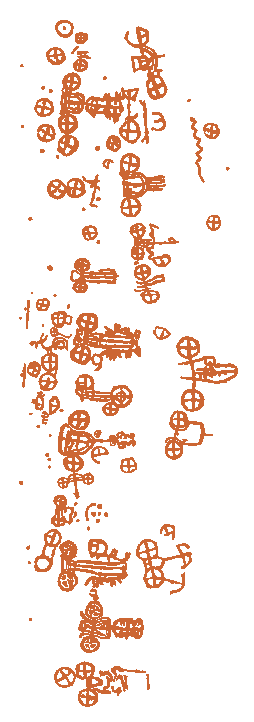Bronze Age rock art along Sweden's south-east coast is rich but not as varied as that of the famous west-coast region. One motif that we have been missing is the four-wheel wagon. It isn't common anywhere except on one site, Frännarp in inland Scania (below right), but we have had none whatsoever where I am.
The other day we got our first wagon: at the rich classical site of Himmelstalund on the outskirts of Norrköping in Östergötland province. According to period convention, it is depicted in a flattened perspective with the wheels seen from the sides and the carriage from the top. The drawbar is cut by a later ship (off camera), and it appears that there were never any draught animals. The wagon probably dates from the centuries about 800 BC.
This rock art is carved into the smooth surfaces left by the inland ice. The paint and chalk is recent. The red-painted figure above the Himmelstalund wagon is a pair of incomplete foot soles or shoes. The thin chalk lines represent two ships that appear to have been mostly weathered away before the wagon was carved. People returned to these panels and made additions for centuries.
Note that the person who painted the foot soles didn't see the wagon or the faint ships! This shows how important it is to return to rock art panels regularly with skilled personnel for renewed study. In this case I can take a small amount of avuncular pride in the find, because Theres Furuskog is a long-time collaborator of mine who has done GPS surveying, fieldwalking and metal-detecting with me on many sites in Östergötland and Södermanland. She has also worked for years with cleaning and painting rock art. Her find is a prime example of how important it is to employ educated, intelligent and experienced people for such tasks.
Another fine first in east-coast rock art was the sun horse of nearby Gärstad, found in 2011.


Another 4-wheel wagon from the same area. A little bit atypical, but real nice.
http://www.fmis.raa.se/cocoon/fornsok/scanned_ref.pdf?label=Rystad+235%…
Do we know what they used to carve the rocks: harder stones? Bronze points? It sounds like the lines were never very deep, but that is carved granite.
How do they date rock art?
They used harder stones. Much of the art is pecked rather than carved or incised.
We date rock art mainly from stylistic traits, locking the art into the well-understood sequence of artefact type combinations in graves and hoards by means of bronze objects with similar art on them. This relative sequence has been assigned absolute dates using radiocarbon.
Very cool! Looks a lot like the famous one on the Hochdorf couch. I wonder if this is the bronze-age equivalent of me doodling ferraris on my schoolwork when I was a kid.
Wow Kevin, I didn't know about that one! Here it is: http://www.laits.utexas.edu/ironagecelts/hochdorf3.php
In countries that have mud wasps, you can bracket rock art between C14-datable wasp nests. Not perfect, but useful. Could the name Himmelstalund be an echo of early cult practices?
Lack of wagon rock art on the East coast.
(Vison of rivalry between West coast rockers and East coast rockers triggerered by disrespectful lyrics of bronze horn music: Eastcoasters gets rubbed out by a hail of arrows as Westcoasters drive by)
Haha perfect, Birger, Sip mead 'til my throat drown
New four-wheeled cart, No Malice
Count Sassanid drachms 'til our hands get calloused
Ulfberhts in the skeið, welcome to Stora Hammars
When they blow them lurs I'm coming
Torch in hand, yes, I'm running...
(apologies for all the anachronisms)
Martin there was a really cool four-wheeled cart in the Hochdorf burial, too, another rare chance (like the Oseberg cart and tapestries) to see maybe something like the actual conveyance being portrayed.
There are several wagons of this kind in mediterranean rock art of France and Italy, like this one from Valcamonica:
http://commons.wikimedia.org/wiki/File:Carro_a_quattro_ruote_-_C%C3%B2r…
Short TV about Frännarp in Swedish only: http://www.skanskan.se/webbtv/2424059342001/bertils-parlor-del-49---de-…